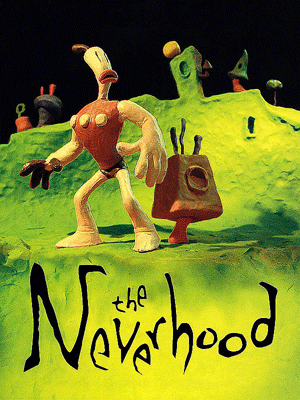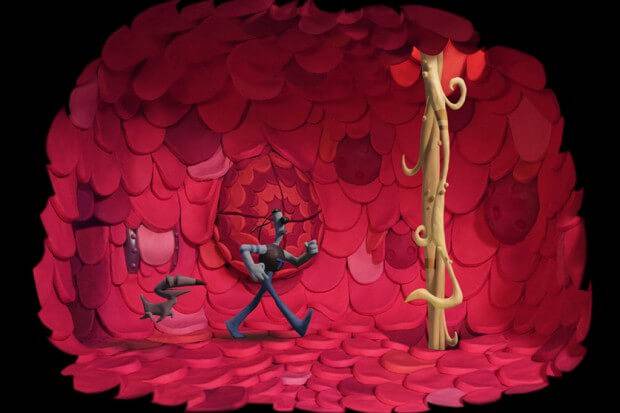A Conversation with ‘Armikrog’/‘Earthworm Jim’ creator Doug TenNapel
Tennessee-based artist Doug TenNapel‘s output ranges from graphic novels (including such brilliantly-drawn works as Creature Tech, Ratfist and the ongoing Scholastic Graphix series Nnewts) to animated TV shows such as the Nickelodeon series Catscratch and presently VeggieTales in the House for Netflix. To many, however, Doug is perhaps most known for bringing his extraordinary and inventive visual style to video games such as the gloriously daft 16-bit platformer Earthworm Jim and classic point-and-click adventure The Neverhood, two series that expertly married gaming with traditional 2D animation and stop motion respectively. In 2013 TenNapel joined forces with longtime collaborators Mike Dietz and Ed Schofield of Pencil Test Studios (along with composer Terry Scott Taylor) to successfully crowdfund an all-new adventure game embracing the use of stop-motion even further with Armikrog. In the game, which is released on multiple platforms today, the player takes control of Tommynaut (played by Michael J. Nelson of MST3K fame) to explore the bizarre titular universe through a series of puzzles and explorations, aided by his blind alien companion Beak-Beak (voiced by veteran performer Rob Paulsen). In anticipation of the game’s release Skwigly were delighted to learn more about the project from the creator himself.
You have quite a smörgåsbord of regular output, from graphic novels to animated series to video games – were you always artistically inclined?
I’ve always drawn, my earliest memories are of drawing. My great treasure was 8.5 x 11 paper and a no. 2 pencil and I would just go crazy with it. I always just created my own thing instead of colouring in colouring books, with the exception of some Disney books where I would just copy everything with the purpose of trying to learn to draw like they do. So I’ve always pretty much been an artist, I never had to try hard or work at it, and if I never made a living out of it I’d still try to be an artist on my own. It’s kind of my happy place.
How did the idea for Armikrog originally come about?
Mike and Ed and I just had an informal conversation because I was thinking about doing a Kickstarter – because I had just done a Kickstarter for my sketchbook, which was really successful, they were impressed with that and so I went to them and said “Guys, what if we did an animated feature?” It was probably a week or two of plunking around with the movie idea, and then I think it was Mike who came up with the idea of going “Look, we have nothing to lose, we have the most notoriety from Neverhood and Earthworm Jim, we still get tons of fanmail every week from around the world. Why don’t we do a game?” And my mouth dropped open, I just said “Why didn’t I think of that before?” because it made perfect sense as soon as he said it. And we all kind of said at the time “Puppet animation? Puppet animation!”
So the opportunity was sitting there, they thought it was a good and Mike said “Doug, come up with anything you want”. I started drawing Tommynaut and Beak-Beak for the first time in a sketchbook. Armikrog is a big mystery with a big backstory, it has a real deep mythology to it. So I presented a few of the characters and the main ideas, I asked Mike and Ed what they thought of the palettes and went back and forth. To me the biggest controversy was that Tommynaut’s eyes are black, solid spheres. We hadn’t seen that on any other character before, because usually I would do the carved eyes in Klaymen and before that on Earthworm Jim with the big, bulging, Tex Avery eyes. I did a couple of drawings for Mike saying how you’d mould the clay to look like he’s looking right, surprised, eyes closed and stuff, and he said “I think we can pull that off”. Then I wrote the intro movie that you see for the Kickstarter, it was originally a little longer but we cut it down to that. So we had to line up a programmer and shot that intro movie over a period of about a month. I flew out to Colorado Springs for about two weeks to pencil-test and build the sets, work on the ideas and all that and we shot it and it just looked crazy. I was already friends with Rob Paulson and Mike Nelson, so I knew I had two great voices, although Mike Nelson had never done that kind of cartoon character work before.

The Neverhood (1996) box art
Certainly in a visual sense the game seems like a companion to The Neverhood, was it tricky to get the balance right between an established look and a new concept?
We were loosely trying to fit it within the Neverhood game mechanic of point-and-click adventure, mostly because that was the easiest thing to do that would show off our animation. There was always just that kind of nagging thing in all of our guts of “How much are we just gonna copy Neverhood?” and I really kept veering away from that. I really want to create something new. It would be easy to just do a knock-off – that’s not in my vocabulary. If you know where I come from, that’s just not how I do it.
Did any of you anticipate such an immense response from the project’s backers when you were raising funds?
We really didn’t know what to expect on the Kickstarter. We didn’t know if the fans would show up or not. They really surprised us with how many of them showed up. You’re getting $25 at a time for the most part, there’s very few big spenders in there. Then there are people donating from Russia who just don’t have a dime and they’re scraping it together to buy a copy of the game, that part of it was amazing.
What considerations do there need to be when writing for an interactive story with multiple variations as opposed to a more singular narrative?
The story has to be way more editable. Mike and Ed do a lot of editing and a lot of writing on their own, because they don’t need to call me to tell me a line’s not working out because they’ve changed the gameplay – they’ll just write that line up and go for it. So it has to be more open-ended.
On top of the visual development were you involved much in the mechanics and structure of the game itself?
After the money came in was when I really designed the game. I invited two friends over to my house for three days, we basically would just spitball ideas and we built most of the game in cardboard on my living room table. So all those buildings that you see had cardboard representations, so a really basic box would represent Room B. In The Neverhood all the rooms were fixed, while in this game you can move some of the rooms around to change the way the puzzles connect, so it’s like a puzzle in a puzzle, loosely. We ended up cutting a lot of those features out, just for time, but we always over-design our games – in Neverhood we designed at least another third or two thirds that we cut out.
Also returning to the fold is longtime musical collaborator Terry S. Taylor. What sort of working dynamic do the two of you have that works so well?
With all my creative guys, being a writer, I come from the art form as an artist and not as an executive. I think you get the best art from artists by pushing the responsibility on them to entertain and figure it out. So my musicians are the same way, on Armikrog I just gave Terry a whole bunch of music that I knew he liked but he knew I loved also. Terry’s always a brilliant musician who can write anything really – he’s done country, he’s done rock and he can do folk and all these different kinds of music. I’m not a musician at all so I just want him to surprise me and I want Armikrog to have this unique presence, because that’s what music’s supposed to do, right? It tells an emotional story and can keep you in a place that the narrative just can’t hit. So it’s almost like I want Terry to be in charge of the psychology of Armikrog; it’s angsty, it’s moody, it’s heroic.
Armikrog is out today via Steam on Windows, Mac and Linux, with an upcoming Wii U release planned for the near future. To learn more about the work of Doug TenNapel keep your ears open for the next episode of the Skwigly Podcast. You can visit his official site at tennapel.com


